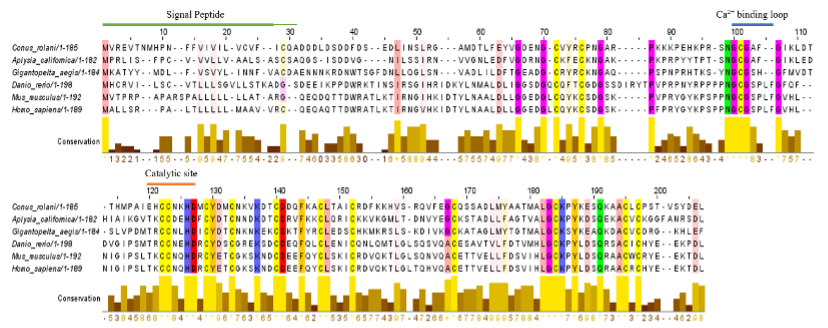VOLUME 17 (Supplement)

SciEnggJ 17 (Supplement) 120-131
available online: April 22, 2024
DOI: https://doi.org/10.54645/202417SupQCH-42
*Corresponding author
Email Address: aolluisma@up.edu.ph
Date received: December 13, 2023
Date revised: February 12, 2024
Date accepted: February 20, 2024
ARTICLE
Diversity and novelty of venom peptides from Conus (Asprella) rolani revealed by analysis of its venom duct transcriptome
Diliman
Conus species in the sub-genus Asprella are poorly studied because they inhabit deep-water habitats. To date, only a few peptides have been characterized from this clade. In this study, the venom duct transcriptome of a member of this clade, Conus rolani, was mined for potential conopeptides. Using a high-throughput RNA sequencing platform (Illumina) and a multiple k-mer de novo assembly, we found 103 putative conopeptide precursor amino acid sequences, including the few peptides previously reported for this species. The sequences, predominantly novel based on amino acid sequence, were diverse, comprising 36 gene superfamilies (including the “unassigned” superfamilies). As observed in other Conus species, the O1 gene superfamily was the most diverse (12 distinct sequences) but interestingly none of the sequences were found to contain the conserved amino acids associated with certain bioactivities in peptides found in piscivorous Conus species. The O2 superfamily was also highly diverse but con-ikot-ikot and an unassigned superfamily (MMSRMG) were more diverse than the rest of the superfamilies. In terms of gene expression levels, the understudied MEFRR paralog of the ancestral divergent M---L-LTVA superfamily was found to be the most highly expressed in the transcriptome, suggesting a novel role. Additionally, a conopeptide with high sequence similarity to A2 secretory group XII phospholipases is the first reported member of this phospholipase group in Conus and potentially represents a novel superfamily, expanding the catalog of known phospholipases present in cone snail venoms. The discovery of these putative conopeptides provides the first but early glimpse of the diversity and novelty of the peptides in the Asprella group and sets the stage for their functional characterization.
© 2025 SciEnggJ
Philippine-American Academy of Science and Engineering